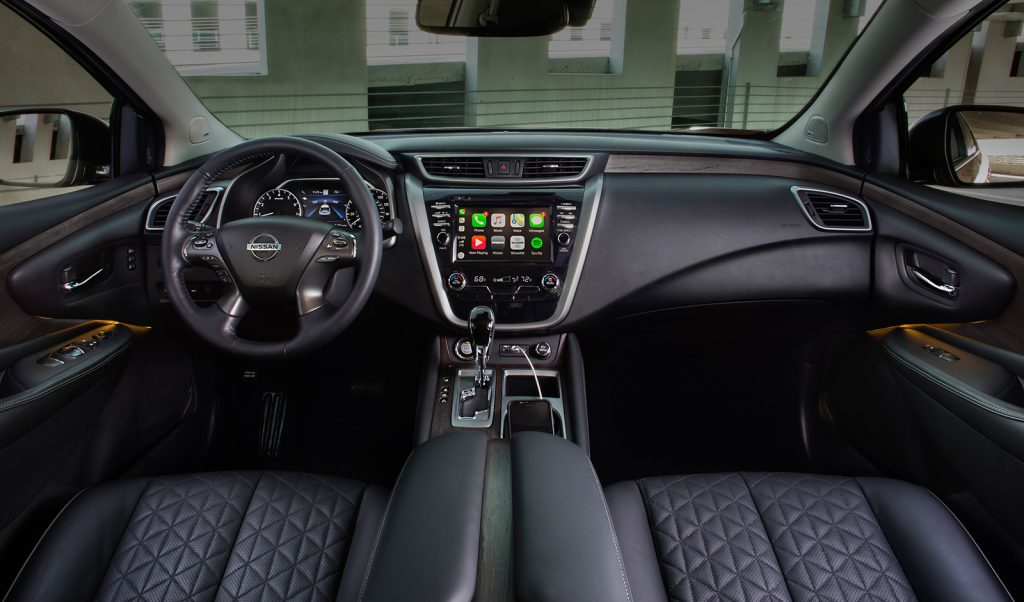Cargazing
By Derek Price
The Nissan Murano avoids my two biggest complaints about crossovers: they all look the same, and they try to be all things to all people.
This is a crossover with a unique look and a very specific mission.
It doesn’t have any pretensions of sportiness, that silly idea that a practical family vehicle is supposed to drive like a sports car.
The Murano also doesn’t try to be a brutish off-road machine, a boxy delivery van or a truck that can tow a million pounds.
Instead, it focuses on one core job: carrying passengers in comfort.
The Murano floats, wafts and glides over the pavement, moving people in the kind of silent serenity that’s rare to find outside of luxury brands. And it does a good job on this people-carrying mission because it doesn’t get distracted by the many other things modern buyers expect their crossovers to do.
Some people see this as a weakness. The Murano sometimes gets criticism for not towing enough, not hauling enough or not being built for trail running.
I see it as a strength, though. Even as its platform ages, this is still one of the best riding over-the-road vehicles I’ve driven in the past year. A compliant suspension, excellent sound insulation and soft, squishy, recliner-like front seats make its cabin a plush place to spend hours on the highway.

Break-from-the-pack styling has been an important part of the Nissan Murano’s formula since it was introduced in 2003.
A standard 3.5-liter V6 makes 260 horsepower, plenty for merging and passing. The engine is pleasantly silky compared to the four-cylinder power plants in many of the Murano’s competitors.
A continuously variable transmission adds to the buttery experience. While I think CVTs are a scourge on Nissan’s smaller vehicles, where they sap all the zippy fun out of driving a compact car, they’re an ideal fit on a vehicle designed for comfort.
The CVT also helps it achieve decent fuel economy of 28 mpg on the highway. It’s rated for a less impressive 20 mpg in city driving which, interestingly, is exactly the same whether you pick the front-wheel-drive or all-wheel-drive version. There’s no difference in the government’s gas-mileage rating.
It also looks refreshingly unique, something that’s been a part of its packaging since it was introduced in 2003. It stands out a bit from the lookalike crossover pack with waves, creases and swooping lines that add interest to its sheetmetal.

The Murano is designed first and foremost for passenger comfort. A quiet cabin, soft seats and compliant suspension tuning combine for a serene feeling on highway trips.
The Murano is a tool built to do one job well. I think buyers who understand that reality will be well served by it as a luxurious, passenger-wafting machine.
They’ll also benefit from more standard safety features. Nissan makes the Safety Shield 360 package standard equipment on all four trim levels, including rear automatic braking.
Buyers who need to do towing, off-roading or hauling bulky cargo would be better served by other vehicles, some of which will be parked next to it in Nissan’s showrooms.
Pricing starts at $32,610 for the S trim, while all-wheel drive adds another $2,000 if you want it. SV, SL and Platinum grades add more luxury content, topping out at $45,610 for the AWD Platinum model.
At A Glance
What was tested? 2021 Nissan Murano Platinum AWD ($45,610). Options: Carpeted floor mats ($250), interior accent lighting ($300), exterior accent lighting ($395), 20-inch wheels ($1,730). Price as tested (including $1,095 destination charge): $49,380
Wheelbase: 111.2 in.
Length: 192.8 in.
Width: 75.4 in.
Height: 67.8 in.
Engine: 3.5-liter V6 (260 hp, 240 ft.-lbs.)
Transmission: Continuously variable
Fuel economy: 20 city, 28 highway
RATINGS
Style: 9
Performance: 8
Price: 8
Handling: 4
Ride: 9
Comfort: 9
Quality: 8
Overall: 8
Why buy it?
It’s smooth, quiet and distinctive looking. It remains one of the best crossovers on the market for carrying passengers in silent comfort.
